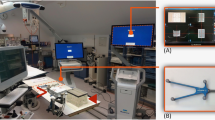Abstract
Purpose
Treatment of vascular malformations requires the placement of a needle within vessels which may be as small as 1 mm, with the current state of the art relying exclusively on two-dimensional fluoroscopy images for guidance. We hypothesize that the combination of stereotactic image guidance with existing targeting methods will result in faster and more reproducible needle placements, as well as reduced radiationexposure, when compared to standard methods based on fluoroscopy alone.
Methods
The proposed navigation approach was evaluated in a phantom experiment designed to allow direct comparison with the conventional method. An anatomical phantom of the left forearm was constructed, including an independent control mechanism to indicate the attainment of the target position. Three interventionalists (one inexperienced, two of them frequently practice the conventional fluoroscopic technique) performed 45 targeting attempts utilizing the combined and 45 targeting attempts utilizing the standard approaches.
Results
In all 45 attempts, the users were able to reach the target when utilizing the combined approach. In two cases, targeting was stopped after 15 min without reaching the target when utilizing only the C-arm. The inexperienced user was faster when utilizing the combined approach and applied significantly less radiation than when utilizing the conventional approach. Conversely, both experienced users were faster when using the conventional approach, in one case significantly so, with no significant difference in radiation dose when compared to the combined approach.
Conclusions
This work presents an initial evaluation of a combined navigation fluoroscopy targeting technique in a phantom study. The results suggest that, especially for inexperienced interventionalists, navigation may help to reduce the time and the radiation dose. Future work will focus on the improvement and clinical evaluation of the proposed method.









Similar content being viewed by others
References
Yakes W, Baumgartner I (2014) Interventional treatment of arterio-venous malformations. Gefässchirurgie 19(4):325–330
Donnelly LF, Bissett GS, Adams DM (1999) Combined sonographic and fluoroscopic guidance: a modified technique for percutaneous sclerosis of low-flow vascular malformations. Am J Roentgenol 173(3):655–657
Andreisek G, Nanz D, Weishaupt D, Pfammatter T, Imaging-guided MR (2009) Percutaneous sclerotherapy of peripheral venous malformations with a clinical 1.5-T unit: a pilot study. J Vasc Interv Radiol 20(7):879–887
Lewin JS, Merkle EM, Duerk JL, Tarr RW (1999) Low-flow vascular malformations in the head and neck: safety and feasibility of MR imaging-guided percutaneous sclerotherapy-preliminary experience with 14 procedures in three patients. Radiology 211(2):566–570
Nesbit GM, Nesbit EG, Hamilton BE (2011) Integrated cone-beam CT and fluoroscopic navigation in treatment of head and neck vascular malformations and tumors. J Neurointerv Surg 3(2):186–190
Hoffmann J, Westendorff C, Troitzsch D, Ernemann U, Reinert S (2004) Image-guided navigation for the control interstitial laser therapy of vascular malformations in the head and neck region. Biomedical engineering 49(7–8):199–201
Mathiesen T, Peredo I, Edner G, Kihlström L, Svensson M, Ulfarsson E, Andersson T (2007) Neuronavigation for arteriovenous malformation surgery by intraoperative three-dimensional ultrasound angiography. Neurosurgery 60(4 SUPPL. 2):345–351
Unsgaard G, Ommedal S, Rygh OM, Lindseth F (2005) Operation of arteriovenous malformations assisted by stereoscopic navigation-controlled display of preoperative magnetic resonance angiography and intraoperative ultrasound angiography. Neurosurgery 56(4 SUPPL.):281–290
Raza SM, Papadimitriou K, Gandhi D, Radvany M, Olivi A, Huang J (2012) Intra-arterial intraoperative computed tomography angiography guided navigation: a new technique for localization of vascular pathology. Neurosurgery 71(SUPPL.2):240–252
Coenen VA, Dammert S, Reinges MHT, Mull M, Gilsbach JM, Rohde V (2005) Image-guided microneurosurgical management of small cerebral arteriovenous malformations: the value of navigated computed tomographic angiography. Neuroradiology 47(1):66–72
Muacevic A, Steiger HJ (1999) Computer-assisted resection of cerebral arteriovenous malformations. Neurosurgery 45(5):1164–1171
Toporek G, Wallach D, Weber S, Bale R, Widmann G (2013) Cone-beam computed tomography-guided stereotactic liver punctures: a phantom study. Cardiovasc Interv Radiol 36(6):1629–1637
Widmann G, Wallach D, Toporek G, Schullian P, Weber S, Bale R (2013) Angiographic C-arm CT-versus MDCT-guided stereotactic punctures of liver lesions: nonrigid phantom study. Am J Roentgenol 201(5):1136–1140
Koethe Y, Xu S, Velusamy G, Wood BJ, Venkatesan AM (2014) Accuracy and efficacy of percutaneous biopsy and ablation using robotic assistance under computed tomography guidance: a phantom study. Eur Radiol 24(3):723–730
Peterhans M, Berg A, Dagon B, Inderbitzin D, Baur C, Candinas D, Weber S (2011) A navigation system for open liver surgery: design, workflow and first clinical applications. Int J Med Robot Comput Assist Surg 7(1):7–16
Wallach D, Toporek G, Weber S, Bale R, Widmann G (2014) Comparison of freehand-navigated and aiming device-navigated targeting of liver lesions. Int J Med Robot Comput Assist Surg 10(1):35–43
Brooke J (1996) SUS-a quick and dirty usability scale. Usability Eval Ind 189(194):4–7
Acknowledgments
The work presented in this manuscript was partially funded by the Ruth & Arthur Scherbarth Stiftung. The authors would like to acknowledge Huanxiang Lu, Matteo Fusaglia, Denise Baumann, Matthias Peterhans, and Juan Ansó for advice, and CAScination AG for providing the IGS system used in the experiments.
Author information
Authors and Affiliations
Corresponding author
Ethics declarations
Conflict of interest
The authors declare that they have no conflict of interest.
Human and animal rights
This article does not contain any studies with human participants or animals performed by any of the authors.
Rights and permissions
About this article
Cite this article
Schwalbe, M., Haine, A., Schindewolf, M. et al. Feasibility of stereotactic MRI-based image guidance for the treatment of vascular malformations: a phantom study. Int J CARS 11, 2207–2215 (2016). https://doi.org/10.1007/s11548-016-1417-0
Received:
Accepted:
Published:
Issue Date:
DOI: https://doi.org/10.1007/s11548-016-1417-0




